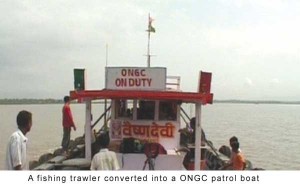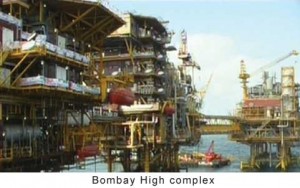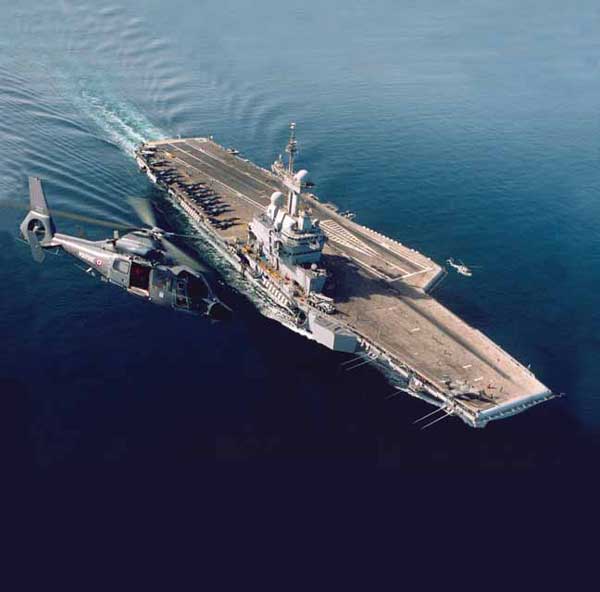Cross border terrorism has taken an entirely new dimension. The Indian security establishment is on high alert to tackle the newest frontier of terror – Maritime Terrorism. The Council for Security Cooperation in the Asia Pacific (CSCAP) Working Group has defined maritime terrorism as:“…the undertaking of terrorist acts and activities within the maritime environment, using or against vessels or fixed platforms at sea or in port, or against any one of their passengers or personnel, against coastal facilities or settlements, including tourist resorts, port areas and port towns or cities.”
But in the context of Mumbai 26/11 terrorist attack, maritime terrorism now needs to be redefined as any act of terror that emanates from the sea route, whether its eventual intended target is on land or within the maritime environment. This would, therefore, include “the use or threat of violence against a ship (civilian as well as military), its passengers or sailors, cargo, a port facility” as stated by Akiva J Lorenz: Al Qaeda’s Maritime Threat, published in the Institute for Counter-Terrorism. (http://www.instituteforcounterterrorism.org/)
Of particular concern for India are Lashkar-e-Tayebba’s, also spelt as Lashkar-e-Toiba, (LeT) plans to use the sea-route to infiltrate and attack India’s oil assets in Bombay High, sabotage ports and target high value assets such as the atomic power plants located on the coast or attack INS Vikrant, India’s only aircraft carrier while it is ensconced in dry dock facilities at the Cochin Naval Base.
Bombay High, 160 Kilometers off Mumbai produces a third of the country’s oil. But what is the real security presence around these oil rigs? An on the spot check two years ago by the author had revealed that re-labeled fishing boats were hired by ONGC to keep trawlers 500 meters away from the platforms (See Photograph). More than a year before the Mumbai 26/11 terror attack in which the terrorists came in through the sea route from Karachi, Indian intelligence agencies had warned the government on a new emerging threat-Maritime Terrorism.
Intelligence agencies had informed the government that nearly 500 LeT terrorists were being trained in the Azizabad coastal camps near Karachi to execute acts of maritime terrorism within India’s Exclusive Economic Zone…
Intelligence agencies had informed the government that nearly 500 LeT terrorists were being trained in the Azizabad coastal camps near Karachi to execute acts of maritime terrorism within India’s Exclusive Economic Zone(EEZ) as well as attack high value assets along India’s more than 7,000 kms mainland coastline. The first such six-month maritime terror training started in October 2006 got over in March 2007. In fact, the Ministry of Defence in a written reply at 15:45 IST to the Lok Sabha on March 08, 2007 made the following statement on infiltration of terrorists through the sea route:
“…The intelligence agencies have warned about the possibility of terrorists trying to infiltrate through the sea route or trying to target our offshore installations. There are reports about terrorists of various tanzeems being imparted training and likelihood of their infiltration through sea routes. India’s coastal waters are guarded by the Indian Coast Guard in coordination with the State Police and the Navy. The Coast Guard has plans to augment its strength, infrastructure and other assets to further improve its effectiveness all along the coastal areas including Kerala.
Maritime terrorism, gun-running, drug trafficking and piracy are major threats that India is facing from the sea borders of the country. The measures that have been taken and planned to enhance the coastal security include regular aerial surveillance and maritime patrolling along the coast, establishment of coastal police stations in the littoral States, as part of Coastal Security Scheme, vessels monitoring system, etc.”
Fishing Vessels As Terrorist Tool
Yet, one and half years later Mumbai was attacked. Therefore, the question that needs an honest introspection is – are all these agencies along with the Coast Guard and the Navy, in the short and long term, prepared, equipped and trained in maritime counter-terror operations to thwart, prevent and deter another terror attack either on the high seas or a Mumbai 26/11 on any other location? The Coast Guard is still woefully short of fast patrol boats to prevent a suicide squad of terrorists who could commandeer a fishing boat, load it with explosives and ram into the oil rigs. Such a maritime fidayeen attack will have a devastating effect. That’s why the Navy and Coast Guard want faster patrol boats that can do this job of securing the oil rigs more effectively.
 “The boats that we have to assist ONGC are slow and these are an interim arrangement until we get fast boats,” says Rear Admiral, Mahendra P Taneja, Former Flag Officer Defence Advisory Group. But the Coast Guard and Navy’s request for faster interceptor boats, which can clock speeds upto 40 knots has still not been met.
“The boats that we have to assist ONGC are slow and these are an interim arrangement until we get fast boats,” says Rear Admiral, Mahendra P Taneja, Former Flag Officer Defence Advisory Group. But the Coast Guard and Navy’s request for faster interceptor boats, which can clock speeds upto 40 knots has still not been met.
As a result until those fast boats arrive, India’s crucial economic asset, the Bombay High, worth several thousand crores continues to be vulnerable to Pakistani Inter Services Intelligence (ISI) covert terrorism strikes outsourced to LeT’s maritime terror trained operatives. For nearly two years now Indian intelligence agencies were worried that Pakistan’s ISI could misuse hundreds of Indian fishing boats seized over the years by the Pakistani Navy and Coast Guard for allegedly straying into Pakistani territorial waters. In fact, the thinking within the national security establishment was that these fishing boats could be used by Pakistan based terrorists to infiltrate into Indian waters.
In fact, the National Fishworkers Forum (NFF) and various other organizations representing the Indian fishermen have constantly been alerting the governments of the coastal states and the central government of the need to engage them in effective policing of coastal waters.
Maritime terrorism, gun-running, drug trafficking and piracy are major threats that India is facing from the sea borders of the country.
“It is quite easy for a fishing trawler or any other similar boat to fly an Indian flag to enter Indian territorial waters. I am saying this because we are out on the seas for months together and often we hardly encounter either the Coast Guard or Navy. Our territorial waters can be easily penetrated,” says Rajendra Shantaram Meher, Chairman, Satpati Fishing Society. Satpati is around three hours drive from Mumbai.
The Coast Guard says that it will need much greater force and a larger fleet to keep Indian waters safe. Several months ago A Rajshekhar, the then IG (West) Coast Guard was quoted in the media that the coastal force would “need more aircraft and ships and we hope the government will give us these. And you have to still appreciate we cannot be in all the places at all the time.” The fact is that India’s coastal regions remain porous and vulnerable to terrorist incursions.
Pirates as Mercenaries
Securing long coastline is a serious challenge for India. In 2007 the Government sanctioned Rs 500 crores to implement a four-year plan to strengthen the coastal security infrastructure and prevent acts of terrorism in India’s territorial waters. Strangely, while Mumbai 26/11 apparently woke the country out of slumber, security analysts have been warning about some disturbing scenarios of what terrorism in the seas could be like.
 In fact, the national security establishment is aware that if effective maritime counter terror measures are not put in place immediately it is quite possible for such scenarios to come true. Like, for instance, a 100,000-ton oil tanker blows up in the Arabian Sea close to the Indian coast or a LPG tanker docked in an Indian harbour is blown up causing enormous economic loss and a high death and injury count. And now the rampant piracy off the coast of Somalia has forcefully reminded security and strategic experts that terror operations could well be outsourced to sea pirates as well. A hijacked merchant vessel carrying several thousand tons of the inflammable fertilizer ingredient ammonium nitrate could easily be turned into a mega bomb after entering an Indian harbour.
In fact, the national security establishment is aware that if effective maritime counter terror measures are not put in place immediately it is quite possible for such scenarios to come true. Like, for instance, a 100,000-ton oil tanker blows up in the Arabian Sea close to the Indian coast or a LPG tanker docked in an Indian harbour is blown up causing enormous economic loss and a high death and injury count. And now the rampant piracy off the coast of Somalia has forcefully reminded security and strategic experts that terror operations could well be outsourced to sea pirates as well. A hijacked merchant vessel carrying several thousand tons of the inflammable fertilizer ingredient ammonium nitrate could easily be turned into a mega bomb after entering an Indian harbour.
Could piracy on high seas morph into this new face of terrorism? With well armed Somali pirates wreaking havoc on shipping lanes from the Indian Ocean to the Gulf of Aden between Somalia and Yemen, Al Qaeda and its associate terror groups could easily outsource maritime terrorism to mercenary pirate groups. From seizing cargo ships to supertankers ferrying millions of dollars of crude oil, the Somali pirates attacked and hijacked 90 vessels in 2008 for ransom and looting cargo from wheat to chemicals.
In the process they have made millions of dollars reselling these items and have now become a major security risk for Indian and international shipping industry, trade and economy. So could sea piracy be converted into a terror operation? Security experts suggest that terror groups could easily rope in pirates who have good knowledge of shipping routes, have access to satellite phones and communication links with ports in the region which enable them to access accurate satellite communication about cargo shipping lines.






The issue with terrorism is, that it is increasingly pan-nation, and carried out by parties that are also seen as suspect by their own nations, religious affiliation etc.. It might be, that Pakistan says that the Lashkar is a legitimate party, to other nations, because they want the Lashkar and it’s views to be relevant to India, and perhaps within Pakistani Punjab also, because they seem to be wanting a relevant outlook. In Pakistan, there were many bomb blasts reported in the Punjab, and if the Lashkar is a registered organization, and seen to be not an affiliation to govt., but registered as some organization, perhaps a charitable organization, then the govt. will have no reason to suspect the organization, and nor will the organization see any relevant reason to the situation.
The U. S. saw a similar situation in Pakistan. In a relevant scenario, every bomb blast in India has a certain reason, but in Pakistan, no bomb blast, in the time when there were about 4 blasts happening every week, was seen to be reported as Indian govt. caused. The Indian press was reporting that the U. S. was aiding Gen. Musharraf, with infusions of Dollar funds, then, and the truth is that it was seen that the Pakistani Gen. was doing the best he could, from preventing Pakistan from collapsing. It seems, that internal security is the need of the minute, then.